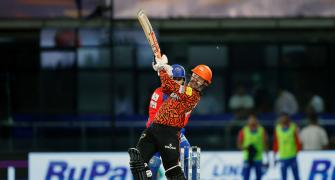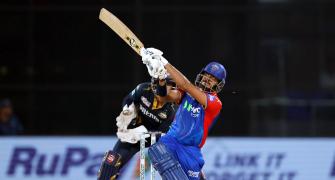On the ropes for a major part of the fourth day, India fought back in the last session to reduce the West Indies to 113 for 4 in their second innings, in the third Test at St Kitts on Sunday.
Medium pacer S Sreesanth claimed two wickets for 19 runs and leg spinner Anil Kumble 2 for 26 as India ended the day happily after being bowled out for 362 in the first innings and conceding a lead of 219 runs.
VVS Laxman provided the lone resistance as the Indian middle order flopped miserably. The Hyderabadi batsman's brave 100, his 10th Test century, and a 10th wicket stand of 47 runs between Harbhajan Singh (38 not out) and Munaf Patel (13) gave some respectability to the Indian total.
Harbhajan slammed four successive fours off fast bowler Jerome Taylor, who broke the back of Indian batting in the morning session to return with figures of 3-117. Corey Collymore (3-63), Pedro Collins (2-117) and Dwayne Bravo (2-38) also chipped in to send the Indians crashing.
Thankfully West Indies captain Brian Lara decided against enforcing the follow on.
Morning sessionThe dismissal of Rahul Dravid off the 11th ball of a fourth morning where play yet again started half an hour early was a whiff of pure oxygen for what, on day three, seemed a dying Test.
Jerome Taylor bent one back in off the seam on length; Dravid defended down the wrong line and took it on his front pad, marginally outside line of off stump, and umpire Brian Jerling got to raise his finger for the first time, for an LBW decision, in his career (157/3; 22/46 Dravid).
The thing is, Dravid was out, if you interpret the LBW law the way it is meant to be - the ball was in the channel and close to the stumps, it was clearly moving in towards the batsman and the stumps and, as clearly, if the pad had not intervened, it would have hit somewhere between off and middle - to my mind, that called for the finger. (I know the rule says if the batsman is playing a stroke and is hit even fractionally outside off, he is deemed not out, but I think that is a sucky rule, so.)
Commentators in the box have been raising eyebrows at the decision - and that owes to two factors. The first is what I mentioned in parenthesis above -- the fact that Dravid was clearly playing a defensive stroke - his bat was in front of the pads and pushing at the ball at the time of impact, and the rule says.
More to the point, though, it was inconsistent umpiring by an adjudicator who through the duration of the West Indies innings turned down a good half dozen dead on the money appeals. I mean, Corey Colleymore was hit just above the ankle, on the back foot, after having gone back into his crease to the first ball he faced from Harbhajan Singh. The ball was in line with middle, the strike was about five inches in front of the stumps, and yet there was some `doubt' for the umpire to give the batsman the benefit.
For that umpire to raise his hands to this one is precisely the kind of thing that causes heartburn and, in more heated minds, trigger the sort of `racist' talk that has Malcolm Speed coming up with his own version of the Gettysburg address.
There was no doubt whatsoever about the second wicket, in Taylor's next over. Or more accurately, the only doubt was about the sanity of a batsman who inexplicably seems to have switched from inspirational form to the reverse. The ball was angled across the left hander, and Yuvraj Singh with zero foot movement poked at it in a way that would embarrass even a kid holding a bat for the first time; the resulting edge went comfortably to Denesh Ramdhin (159/4; 0/0).
Two deliveries later, the Titanic hit the iceberg a second time. Taylor bowled one marginally short and angling onto Mohammad Kaif's pads; Kaif, moving onto middle, flicked and missed and umpire Jerling was again quick to send the batsman back to the hut (159/5; 0/0).
This time round, though, there was a definite problem - the ball was clearly missing the leg stump by a few inches.
The best that could be said for the frenetic period of play was that the spectators had reason to be happy - the newbie umpire had managed, in the space of under half an hour, to revive flagging interest in the Test.
Mahendra Singh Dhoni joined VVS Laxman, and the two settled down to bat in their respective styles. Laxman, who during the second hour of the morning got to his 50 (143 balls; his first 50 in eight innings dating back to the first innings against Pakistan, in January this year) settled down to bat time and looked increasingly solid in front of the wicket and on the on side. Not quite so much outside off, where on occasion he swished and missed, or swished and edged, against the seaming/reversing ball and was lucky to see the nibbles fall short of the slips.
An interesting aspect of how Laxman batted was the very deliberate, very apparent effort he made to not move his front foot quite so much forward and across, concentrating instead on getting the foot beside and not behind the line of the ball and the bat well ahead of the pad. Clearly, the two LBWs of earlier in the morning were working on the batsman's mind - in the way he batted there was intent to not take a ball on the pad, even outside the line, if he could help it.
Dhoni, on the other hand, was a touch painful to watch - not so much because of some technical problem, as because a very conscious decision to bat contrary to his natural free-flowing style found him caught between two stools.
That is most marked in that channel around off - when playing his natural game, his tendency is to glide the front foot forward and hit through the line and very straight; here, he opted for a more defensive approach and his idea of defense to that line is to crawl sideways rather than forward and use his bat like rowers use their oars, in a kind of circular movement calculated to have any decent slip fielder salivating.
Rather curiously, though he had India on the ropes at the start of the session, Lara sat on the fence for the most part. Just two slips, which was even more remarkable against a Dhoni playing the way he was; no particular hurry, no bustle, on the part of either bowlers or fielders, a kind of gentle amble through the proceedings that was inexplicable given the situation. (The slips finally came back into their own just before lunch, for Kumble - three of them and two gullies).
As play wound down towards lunch, India lost another wicket - that of Dhoni who, to a Corey Colleymore delivery angling across him onto leg, again opted to stay half-cock, looking to nudge. He missed, the ball hit the pad in front of middle and leg with the batsman on top of the crease, and umpire Jerling made it a hat-trick of LBWs for the morning and no worries about the slant on the ball taking it past leg stump, either; the dismissal in fact was a carbon copy of the Kaif take-out earlier in the morning. (220/6; 29/56).
You've got to say this for the umpire - if not consistent, he is at least fair. Having spent one entire innings giving everything to the batsmen, he is now spending the next innings giving it all to the bowlers; fair enough.
At lunch, India was on 241/6 after 75 overs; the 150-minute session produced 91 runs in 29 overs for the loss of four wickets.
Post-Lunch session
VVS Laxman spent most of the evening of day three in `I haven't made runs in a while, let me get in and get set' mode.
This morning, it was all about `Let me make sure that my pad is not even in the same zip code as the ball, everything else can wait' mode.
The afternoon session, finally, produced an approximation of the authentic stylist, easy on his feet, increasingly relaxed as he saw Anil Kumble get over early nerves and dig in at the other end.
Taking to Taylor, he first square drove him in classical fashion, then repeated the shot, even better, to the next ball before pulling the bowler imperiously for a brace to the deep fielder when Taylor tried dropping one short; the sequence of shots got him to 99. Taylor was promptly taken off.
In the next over, Laxman moved to his century with a glide to third man off Colleymore, who had taken over from Taylor; the century came ten innings after his 104 in the first innings against Sri Lanka at the Sardar Patel Stadium in Ahmedabad, December 2005. And he walked back to the pavilion next ball, losing concentration and nibbling at a slanting delivery from Collins that found the edge through to the keeper, who dived a long way to hold a superb catch off the top of the grass (297/7; 100/231 deliveries; India 85 shy of the follow-on mark).
In between Kumble, whose assurance on the off was matched only by his discomfort with stuff targeting his ribs, climbed into Collins - a clip to fine leg off his pads, then a crashing square drive through the point region, a top edged pull when Collins banged one in to the fine leg fence, and successive overs from Taylor and Collins after lunch had produced 26 runs. The pair had brought up the 50 of the partnership earlier, off 87 balls.
Lara put in an unusual field of a silly mid off, a short square and leg slip to try and get Kumble fending; the batsman went up on his toes and whacked one high over point for four. Next ball, he swung at another bouncer, and the top edge this time was taken on the second attempt by Collins on the fine leg rope, ending a fighting knock by the tail-ender (311/8; Kumble 43/61; 71 shy of the follow on).
Jerling's umpiring descended from the incompetent to the farcical, when Collins banged one in, Sreesanth attempted to get out of the way, got a glove and handle on the ball and Gayle ran behind the keeper to hold. The batsman was on the walk back to the pavilion when he realized that the umpire not only has his own views on what constitutes LBWs, he is equally idiosyncratic with catches as well - he ruled this one not out.
No matter, the next ball was banged in again and Sreesanth's attempted cut found Lar at second slip (316/9; 0/2).
There followed a spell of interesting hit-out from Harbhajan, and some crude swing and giggle stuff from Munaf Patel. It also calls for an apology of sorts - in the past, I have been caustic at Indian captains ranging from Azharuddin through Tendulkar, Ganguly and Dravid for giving the opposition tail more respect than it deserved.
I was wrong - that is apparently how cricket is played at this level, judging by the vastly experienced Brian Lara spreading his field wider than he did for the likes of Sehwag and Laxman, with Harbhajan Singh on strike. It must do a tailender a world of good to see a deep cover, a deep mid off, a deep mid on, and a deep midwicket confronting him, not to mention a deep fine leg.
Again, since his intent was to get his seamers working on the tail with short stuff, it seemed a tad strange not to take the long-overdue new ball, which would have provided additional bounce; instead, the seamers toiled away with the older, softer one - which sat up nicely and let Harbhajan in particular drive over cover on the up, or pull through midwicket, as the fancy took him while at the other end, Patel negotiated the bounce clumsily, which is to be expected, but far more comfortably than he would have managed against a new ball.
The rule that if there is only one wicket to fall, the break can be extended by half an hour again served to keep the West Indies bowlers toiling for the second straight extended session. Harbhajan Singh made merry, dancing down to Jerome Taylor to slam him to through the right of mid off, then staying back to a slower one and bashing that to the left of the same fielder. The pick of his shots, though, was the third - a wind up, and a clean, classical off drive hit with full flourish, in the fashion of a top class performer. Ball number six was on middle, and again the batsman waited on it and powered it through wide long on by way of variety, to clip 17 off the over.
Watching Collins struggle through the motions, and finally limp off the field, raised a thought about the follow on - which I frankly hope India falls short of, and Lara opts for: There is nothing on the pitch to suggest undue help for spin or seam. And the last Test of this series is three days after this one ends tomorrow.
If I personally - and wearing my Indian-ness on my sleeve quite openly here - wanted to pick one lot of bowlers for over time duty, I'd pick the West Indies; it just means that much more rest for the Indian bowlers. And if the batsmen can't see off the last day on this deck, what the heck, the team deserves to lose anyway. Ball number four was on middle, and again the batsman waited on it and powered it through wide long on by way of variety.
I got my wish, anyways - likely the last ball before tea in the extended session saw Patel guide one straight to Darren Ganga at point (262 all out; 13/41).
So. now what, does Lara get his bowlers back onto the ground and try and win this one?
Post-Tea sessionOnce the West Indies decided (given the nature of the conditions, very wisely in my book) to not enforce the follow on, preferring instead to tray and blaze runs and set India a big target for the last day, it set up a frenetic last session of play.
The fun began in the second over, with Sreesanth firing one down on a middle and leg line leaving the left handed Chris Gayle. The batsman moved across and tried to glide, but merely managed a nick that Dhoni, running a long way around, took with superb control down the leg side (3/1; Gayle 3/8).
With the first ball of the third over, Munaf Patel nailed Ramnaresh Sarwan in front of middle on the back foot; this time, Rudi Koertzen turned the appeal down and, from the fact that the resulting run was credited to the batsman, the umpire clearly reckoned he had gotten an edge. He hadn't, but it was a tough decision for Koertzen to make anyway - not for the line, which was perfectly plumb, but because there was a lot of movement on the part of the batsman, whose bat was very close to ball.
Later in the over, Patel got Darren Ganga to go back and try to force; the ball jagged back and crashed into off stump off the under edge - only, the bowler had over-stepped and Koertzen was quick to spot it and call.
From that point on, Ganga and Sarwan looked to throw their bats at pretty much everything, and the odd mishit was punctuated by some stunningly hit drives on either side of the wicket by both batsmen - all of them off Patel, who continued to look off color while at the other end, Sreesanth held line, length and nerve very well to turn in what, given the situation, was a very miserly spell (4-1-10-1 at the end of eight overs, when Patel was taken off and Kumble introduced at the other end).
In his first over, Kumble got Ganga midway up the pad, in front of the middle stump; Koertzen ruled not out, and he was wrong this time - the ball was hitting midway up the middle stump (45/1; Ganga 17/21). And to think I suggested in the first innings that Kumble should have switched ends, gotten away from Jerling and tried from the other umpire's end.
Sarwan, marginally lucky once already in the innings, fell in the next over, the 10th of the innings. Sreesanth banged one in down the channel, making it climb and straighten; Sarwan shaped to square drive but the bounce, and the straightening of the ball, cramped the shot and the edge picked out Dravid at second slip (46/2; Sarwan 23/28).
Brian Lara took to Kumble at the opposite end, stepping out and launching a fullish leg break outside off back over the bowler's head, and almost out of the ground - a shot hit with tremendous timing, and the cleanest arc through the hitting area you wanted to see. An even better shot, though, was the one in the leggie's next over - again, to the pitched up delivery on off, Lara stayed inside the line, again the arc was perfect, and the ball sailed over the long off fence.
India opted to stay with seam at one end - at least in part, likely, to slow the game down a touch. Munaf thus took the ball back from Sreesanth (6-21-19-2). In the 15th over, Lara survived an appeal for caught behind off Kumble now bowling round the wicket; the next ball saw him dancing down, only to be beaten by the quicker, flatter, shorter delivery fired in at him by the bowler who clearly saw him coming, and be stumped by yards (81/3; Lara 19/15).
Chanderpaul opened with an immaculate pick up off his pads, over the square leg fence for six off Patel. The bowler almost had him in the same over, with a slower one that Chanderpaul misread and pushed back down the track; Patel got down in time, got his hand to it, and watched it slip out again (88/3; SC at the time 6/7).
It was perhaps a commentary on all that was going on out in the middle, that the fire alarm went off at that point, its shrill hoot distracting everyone and bringing play to a standstill. Time was the only thing moving - and it was going in the direction opposite what the West Indies ideally would have wanted it to.
Harbhajan teamed up with Kumble on resumption of play after the unscheduled break, run-making became mostly a question of singles nudged. Kumble bowled one fuller, and Chanderpaul pushed it back down the track for Kumble to dive forward and sideways and take a very good catch (102/4; Chanderpaul 11/24).
The West Indies went in at stumps on 113/4 in 24 overs; an overall lead of 332 runs in the second innings.
At this point, the West Indies are neither here nor quite there. An overnight declaration is not possible, given the final day's play contains close to 100 overs (98, actually, with the early start) and you cannot give a team a chase of just over three an over.
That means continuing the batting in the morning till the overs-and-target equation is balanced in the home team's favor, and each over the West Indies have to bat in the morning is one over less it has to bowl India out in.
There's some artificial interest injected into this game, thanks to the events of the day but at the end of it all, `artificial' is pretty much all it is.








